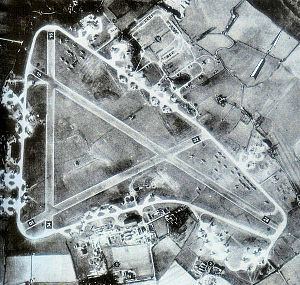Type Military airfield In use 1944-1946 | Code RL Year built 1943 | |
Occupants 363d Fighter Group397th Bombardment GroupNos. 295, 570 Squadrons Garrisons Ninth Air Force, RAF Bomber Command | ||
Royal Air Force Rivenhall or more simply RAF Rivenhall is a former Royal Air Force station located in Essex, England. The airfield is located approximately 4 miles (6.4 km) south-southeast of Braintree; about 40 miles (64 km) northeast of London
Contents
Opened in 1942, it was used by both the Royal Air Force and United States Army Air Forces. During the war, it was used primarily as a combat airfield with various fighter and bomber units. After the war, it was closed in 1946 and kept in reserve until 1956.

Today, the remains of the airfield are located on private property with the northern half being turned into a quarry.
USAAF use

Rivenhall was known as USAAF Station AAF-168 for security reasons by the USAAF during the war, and by which it was referred to instead of location. Its USAAF Station Code was "RL".
363d Fighter Group
On 22 January 1944, a squadron of the 363d Fighter Group arrived from RAF Keevil where it had been awaiting equipment. The group had been selected as the third in the European Theatre to be equipped with the new North American P-51B Mustang. The group consisted of the following operational squadrons:
On 14 April 1944, as part of a general movement of Ninth Air Force fighter units in the Colchester area to the advanced landing grounds, the 363d moved to RAF Staplehurst. The actual movement of all elements had begun two days previously.
397th Bombardment Group
On the day following the departure of the 363d, the first Martin B-26 Marauders of the 397th Bombardment Group arrived from RAF Gosfield. The group consisted of the following operational squadrons:
The group's identification marking was a yellow diagonal band across both sides of the vertical tailplane.
Early in August, officially on the 5th, the 397th transferred from Rivenhall to RAF Hurn in Hampshire, to give the Marauders a better radius of action as the break-out of the Allied forces from the Normandy beachhead meant that potential targets were receding.
Current use
Upon its release from military use, in June 1956, Marconi leased part of the airfield and within ten years had taken over most of the surviving buildings. Today, the northern half of the former airfield has been turned into a quarry, with the vast majority of the land in the northwest of the airfield being excavated.
The perimeter track of the airfield has been reduced to a single track agricultural road. However, some of the loop hardstands still remain in the southwestern quadrant of the field. All three runways either have been quarried, or substantially reduced in width, with agriculture fields taking over the grass areas of the former airfield. A very small portion of the 28 end of the main runway still exists at full width. One T-2 hangar remains, along with a scattering of buildings. An automobile salvage yard has taken over some of the hardstands in the east end of the airfield, where once C-47s and gliders were stored. As of 2013, only one of the two T-2 hangars remain, with demolition claiming the other historical remaining buildings.
